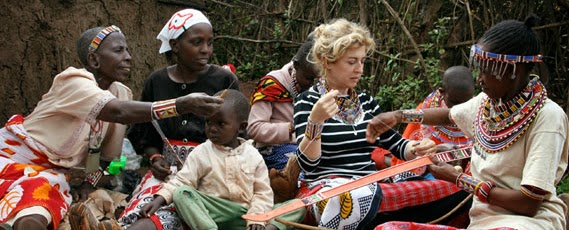 |
| Headbands of Hope founder spreading joy |
In a nutshell:
What they make: Stylish headbands and other headgear (hats, bandanas)
How they make a difference: They bring joy to kids battling cancer by giving them free headbands to help them feel feminine when undergoing chemo
Where to buy their products: Online
Where they are: North Carolina,USA
 There are certain events in life that change all aspects of your life. Cancer is one of them. Thankfully, there are several institutions and organizations that work everyday to bring treatments, pain management and hopefully a cure to cancer patients. But who brings them smiles? Who helps girls continue feeling feminine? That's where Headbands for Hope comes in.
There are certain events in life that change all aspects of your life. Cancer is one of them. Thankfully, there are several institutions and organizations that work everyday to bring treatments, pain management and hopefully a cure to cancer patients. But who brings them smiles? Who helps girls continue feeling feminine? That's where Headbands for Hope comes in.
Inspired by its founder's experience at an internship at the Make-A-Wish Foundation, Headbands for Hope is on a quest to utilize fashion to fight cancer on a double level: for every headband they sell, they give one to a girl affected by cancer and donate $1 to St. Baldrik's Foundation to help fund childhood cancer research.
This is one of the great fashion takes on the one-for-one business model. It is having great success not only because of their heart-touching mission but also because the headbands they offer are beautiful and stylish. From chiffon flowers to simple bows and beaded styles, their collection is vast and addictive. It's a great strategy: The more fabulous the headbands and the bigger the collection, the more you want to buy and the more smiles are delivered to girls with cancer. It is a great vision that combined with beautiful manufacturing and a smart business plan is not just bringing joy to sick children, but also providing people the ability to be a part of a noble cause and a smile-delivering project.
They also make bandanas and headgear for boys, though it is clear that their very-girly-in-a-good-way headbands for girls (and babies!) are their true star products.
I'm very excited to see where this young company goes. They have a great product and a smart mission-driven business model. I don't know how big the company is revenue-wise but I am guessing that in order to continue growing, some possible next steps would be to improve the user experience on their website a bit and also take their headbands to retailers and bigger e-tailers. It would also be great to see them expand their mission outside the United States, to countries where battling cancer is even more difficult. This would not only expand the reach of their help, but also attract global sales.



